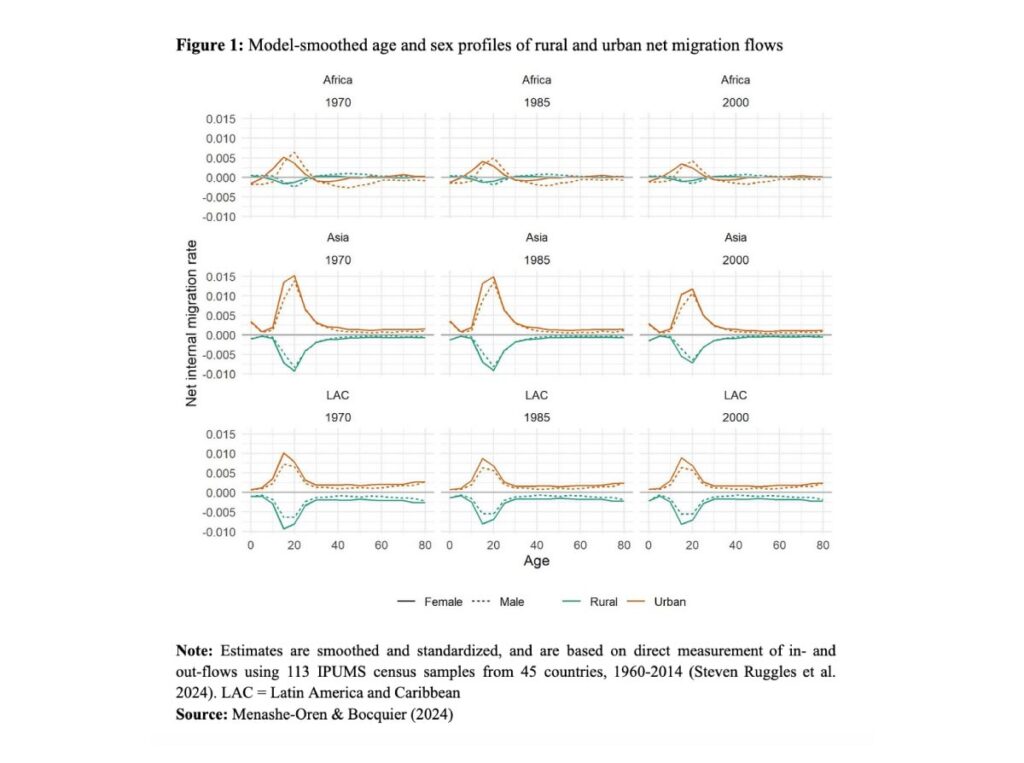Internal migration profiles are heavily delineated by age and sex, but Ashira Menashe-Oren and Philippe Bocquier find that this has little effect on age and sex structures of rural and urban populations. In- and out-migration flows often balance each other out. So, while in Asia migration can speed up the urban transition, in Africa there is actually potential for de-urbanisation.
Internal migration flows are typically delineated by age and sex, with young adults moving the most, and men often moving more frequently than women (Rogers, Raquillet, and Castro 1978). Although such migration profiles are not universal, they do suggest that migration has the potential to dramatically change population structure, both at origin and destination. And not only do migration flows shift people from one place to another, but because they are most common in reproductive ages, future births are also shifted from one region to another. Moreover, changes can be relatively quick in comparison to the slower effects of fertility and mortality changes on population structures. Nonetheless, internal migration flows are rarely one-directional. Some people move from rural to urban areas, others move from urban to rural, and some move within each sector. Thus, it is the balance of in- and out-migration flows, the net migration, that can change rural and urban populations alike.
Net internal migration rates in Asia indicate that the urban sector gains 15-24 year-olds, and within the younger range of this age group, gains more women too (Figure 1). With time however, the peak of net migration in urban areas is reduced. The gain of these young adult migrants in the urban sector is mirrored by their loss from the rural sector. From age 40 on, net migration is close to zero, so likely will not affect either the rural or urban population structures in these ages. In Latin America and the Caribbean, from an earlier age of 25, net migration is also negligible – and this has not changed much over the last couple of decades. Female migration rates in Latin America and the Caribbean are higher than male rates over the life course. In stark contrast to Asia and Latin America, the net migration profiles in Africa are much flatter, with minor peaks in migration rates around age 15 for women and age 20 for men. Additionally, male net migration in the urban sector is negative between ages 35-54, indicating more men leaving cities than moving into them.

Internal migration effect on rural and urban population structures
In light of the net migration profiles explored in Figure 1, we would expect migration to have some role in shaping the age and sex structures of rural and urban populations, particularly in Asia, Latin America and the Caribbean. However, this is not the case – sex ratios and dependency ratios (measures of population structure) are almost identical whether internal migration rates are seen or whether we assume no migration at all (Menashe-Oren and Bocquier 2024). These findings are at the continental level, which may conceal some country-specific differences. All the same, the take-away from this analysis is that internal net migration rates across low- and middle-income countries are not strong enough to significantly affect sub-national population structures.
Rural-urban migration plays a marginal role in urbanisation
Internal migration does not matter much in terms of subnational age structures, but does it contribute to urbanisation? Earlier work finds that urbanisation in Africa and Asia is not generated by rural-to-urban migration but by the urban population itself, be it through the balance of births and deaths (natural growth) or through the expansion of towns and cities to peripheral areas (Bocquier, Menashe Oren, and Nie 2023). In our latest paper (Menashe-Oren and Bocquier 2024), we found that internal migration increases urban growth in Asia and Latin America, but not much in Africa. Net migration gave a strong boost to the urban transition in the 1970s to 2000s in Latin America and the Caribbean. In Asia, since countries still have relatively low proportions of the population living in the urban sector (around 50%), migration has potential in the near future to speed up the urban transition. By contrast, in Africa, migration could actually lead to de-urbanisation, with the urban transition in the continent mostly driven by the rural/urban gap in fertility decline. Critical investments in the rural sector, particularly to face the consequences of climate change on sustainable agriculture, are needed to ensure that the rural population is not left behind, as it is likely to remain large in Africa for many years to come.
References
Bocquier, Philippe, Ashira Menashe Oren, and Wanli Nie. 2023. “Migration’s Contribution to the Urban Transition: Direct Census Estimates from Africa and Asia.” Demographic Research 48: 681–732. https://doi.org/10.4054/DemRes.2023.48.24.
Menashe-Oren, Ashira, and Philippe Bocquier. 2024. “The Potential of Internal Migration to Shape Rural and Urban Populations across Africa, Asia and Latin America.” Population & Development Review, no. Special 50th Anniversary Collection.
Rogers, Andrei, Richard Raquillet, and Luis J Castro. 1978. “Model Migration Schedules and Their Applications.” Environment and Planning A 10 (5): 475–502. https://doi.org/10.1068/a100475.
Steven Ruggles, Lara Cleveland, Rodrigo Lovaton, Sula Sarkar, Matthew Sobek, Derek Burk, Dan Ehrlich, Quinn Heimann, and Jane Lee. 2024. “Integrated Public Use Microdata Series, International: Version 7.5 [Dataset].” IPUMS. Minneapolis, MN.


